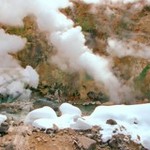 A devastating mudflow in the world-renowned Geyser Valley on the Kamchatka Peninsula has virtually obliterated the natural wonder, forcing the emergency evacuation of visitors and national park personnel, a spokesman for the local emergencies ministry said Monday. The site, which is the Kamchatka Peninsula's main tourist attraction, consists of some 200 thermal pools created by the area's intense volcanic activity, including about 90 geysers covering an area of four square kilometers (2.5 square miles). It is one of only five sites in the world where the impressive eruptions of steam and boiling-hot water can be found..
A devastating mudflow in the world-renowned Geyser Valley on the Kamchatka Peninsula has virtually obliterated the natural wonder, forcing the emergency evacuation of visitors and national park personnel, a spokesman for the local emergencies ministry said Monday. The site, which is the Kamchatka Peninsula's main tourist attraction, consists of some 200 thermal pools created by the area's intense volcanic activity, including about 90 geysers covering an area of four square kilometers (2.5 square miles). It is one of only five sites in the world where the impressive eruptions of steam and boiling-hot water can be found..According to witnesses, a powerful mudslide 1.5 kilometers (one mile) long and 200 meters (600 feet) wide buried more than two-thirds of the valley beneath tens of meters of snow, dirt, trees and boulders Sunday, forcing the emergency evacuation by helicopter of tourists and park personnel.
Tourism officials described the catastrophe as an incredible loss for Russian tourism in general and for the region's economy in particular. About 3,000 visitors are granted access to the unique geyser field every year, paying up to 15,000 rubles ($600) for a four-hour visit. In the photo: the Geyser Valley before the mudflow
"It is a tremendous loss. It is unlikely that the area will ever recover, although it is possible that a new geyser field will emerge," a spokesman for the Russian tourism agency said.
"The biggest springs may still come through the debris, but most of the others are probably lost forever," a local specialist said.
Scientists say the hydrological environment in the valley will change now. The mudslide has pushed the ground waters up, which will affect the geysers’ behavior. A lake may also form in the place where the debris blocked the Geyzernaya River.



